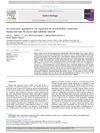Identificador persistente para citar o vincular este elemento:
https://accedacris.ulpgc.es/jspui/handle/10553/71004
| Título: | An integrative approach to the regulation of mitochondrial respiration during exercise: Focus on high-intensity exercise | Autores/as: | Calbet, José A. Martín Rodríguez, Saúl Martín Rincón, Marcos Morales Álamo, David |
Clasificación UNESCO: | 2411 Fisiología humana 241106 Fisiología del ejercicio |
Palabras clave: | Fatigue High-Intensity Exercise Mitochondrial Respiration Oxidative Stress Sprint Performance |
Fecha de publicación: | 2020 | Proyectos: | Viabilidad y Sostenibilidad Del Adelgazamiento Mediante Tratamiento Intensificado en Pacientes Con Sobrepeso U Obesidad: Mecanismos Neuroendocrinos y Moleculares Identificacion E Integracion de Nuevos Factores Moleculares, Fisiologicos y Bioelectricos Determinantes Del Rendimiento en El Ejercicio de Sprint Desarrollo y Caracterización Molecular de Un Nuevo Modelo de Precondicionamiento Remoto Estudio Longitudinal de Los Efectos de Una Modificación Intensiva Del Estilo de Vida en la Composición Corporal E Indicadores Bioquímicos y Moleculares de Salud en Pacientes Con Sobrepeso y Obesidad: Aplicación Para la Evaluación Fisiológica de Rutas y Sistemas de Monitorización Del Esfuerzo |
Publicación seriada: | Redox Biology | Resumen: | During exercise, muscle ATP demand increases with intensity, and at the highest power output, ATP consumption may increase more than 100-fold above the resting level. The rate of mitochondrial ATP production during exercise depends on the availability of O2, carbon substrates, reducing equivalents, ADP, Pi, free creatine, and Ca2+. It may also be modulated by acidosis, nitric oxide and reactive oxygen and nitrogen species (RONS). During fatiguing and repeated sprint exercise, RONS production may cause oxidative stress and damage to cellular structures and may reduce mitochondrial efficiency. Human studies indicate that the relatively low mitochondrial respiratory rates observed during sprint exercise are not due to lack of O2, or insufficient provision of Ca2+, reduced equivalents or carbon substrates, being a suboptimal stimulation by ADP the most plausible explanation. Recent in vitro studies with isolated skeletal muscle mitochondria, studied in conditions mimicking different exercise intensities, indicate that ROS production during aerobic exercise amounts to 1-2 orders of magnitude lower than previously thought. In this review, we will focus on the mechanisms regulating mitochondrial respiration, particularly during high-intensity exercise. We will analyze the factors that limit mitochondrial respiration and those that determine mitochondrial efficiency during exercise. Lastly, the differences in mitochondrial respiration between men and women will be addressed. | URI: | https://accedacris.ulpgc.es/handle/10553/71004 | ISSN: | 2213-2317 | DOI: | 10.1016/j.redox.2020.101478 | Fuente: | Redox Biology [ISSN 2213-2317], v. 35, 101478, (Agosto 2020) |
| Colección: | Artículos |
Citas SCOPUSTM
45
actualizado el 08-jun-2025
Citas de WEB OF SCIENCETM
Citations
39
actualizado el 08-jun-2025
Visitas
276
actualizado el 31-may-2025
Descargas
296
actualizado el 31-may-2025
Google ScholarTM
Verifica
Altmetric
Comparte
Exporta metadatos
Los elementos en ULPGC accedaCRIS están protegidos por derechos de autor con todos los derechos reservados, a menos que se indique lo contrario.
